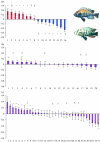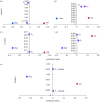Inheritance of female mating preference in a sympatric sibling species pair of Lake Victoria cichlids: implications for speciation
- PMID: 15705547
- PMCID: PMC1634962
- DOI: 10.1098/rspb.2004.2946
Inheritance of female mating preference in a sympatric sibling species pair of Lake Victoria cichlids: implications for speciation
Abstract
Female mate choice has often been proposed to play an important role in cases of rapid speciation, in particular in the explosively evolved haplochromine cichlid species flocks of the Great Lakes of East Africa. Little, if anything, is known in cichlid radiations about the heritability of female mating preferences. Entirely sympatric distribution, large ecological overlap and conspicuous differences in male nuptial coloration, and female preferences for these, make the sister species Pundamilia pundamilia and P. nyererei from Lake Victoria an ideally suited species pair to test assumptions on the genetics of mating preferences made in models of sympatric speciation. Female mate choice is necessary and sufficient to maintain reproductive isolation between these species, and it is perhaps not unlikely therefore, that female mate choice has been important during speciation. A prerequisite for this, which had remained untested in African cichlid fish, is that variation in female mating preferences is heritable. We investigated mating preferences of females of these sister species and their hybrids to test this assumption of most sympatric speciation models, and to further test the assumption of some models of sympatric speciation by sexual selection that female preference is a single-gene trait. We find that the differences in female mating preferences between the sister species are heritable, possibly with quite high heritabilities, and that few but probably more than one genetic loci contribute to this behavioural speciation trait with no apparent dominance. We discuss these results in the light of speciation models and the debate about the explosive radiation of cichlid fishes in Lake Victoria.
Figures



Similar articles
-
Intraspecific sexual selection on a speciation trait, male coloration, in the Lake Victoria cichlid Pundamilia nyererei.Proc Biol Sci. 2004 Dec 7;271(1556):2445-52. doi: 10.1098/rspb.2004.2911. Proc Biol Sci. 2004. PMID: 15590594 Free PMC article.
-
Genetic architecture of a key reproductive isolation trait differs between sympatric and non-sympatric sister species of Lake Victoria cichlids.Proc Biol Sci. 2020 Apr 8;287(1924):20200270. doi: 10.1098/rspb.2020.0270. Epub 2020 Apr 8. Proc Biol Sci. 2020. PMID: 32259470 Free PMC article.
-
Genetics of male nuptial colour divergence between sympatric sister species of a Lake Victoria cichlid fish.J Evol Biol. 2010 May;23(5):914-24. doi: 10.1111/j.1420-9101.2010.01960.x. Epub 2010 Mar 12. J Evol Biol. 2010. PMID: 20345823
-
The diversity of male nuptial coloration leads to species diversity in Lake Victoria cichlids.Genes Genet Syst. 2013;88(3):145-53. doi: 10.1266/ggs.88.145. Genes Genet Syst. 2013. PMID: 24025243 Review.
-
The species flocks of East African cichlid fishes: recent advances in molecular phylogenetics and population genetics.Naturwissenschaften. 2004 Jun;91(6):277-90. doi: 10.1007/s00114-004-0528-6. Epub 2004 Apr 20. Naturwissenschaften. 2004. PMID: 15241604 Review.
Cited by
-
Quantitative Genetic Analyses of Male Color Pattern and Female Mate Choice in a Pair of Cichlid Fishes of Lake Malawi, East Africa.PLoS One. 2014 Dec 10;9(12):e114798. doi: 10.1371/journal.pone.0114798. eCollection 2014. PLoS One. 2014. PMID: 25494046 Free PMC article.
-
Differences in male coloration are predicted by divergent sexual selection between populations of a cichlid fish.Proc Biol Sci. 2016 May 11;283(1830):20160172. doi: 10.1098/rspb.2016.0172. Proc Biol Sci. 2016. PMID: 27147097 Free PMC article.
-
Developmental effects of environmental light on male nuptial coloration in Lake Victoria cichlid fish.PeerJ. 2018 Jan 3;6:e4209. doi: 10.7717/peerj.4209. eCollection 2018. PeerJ. 2018. PMID: 29312830 Free PMC article.
-
A stochastic model for speciation by mating preferences.J Math Biol. 2018 May;76(6):1421-1463. doi: 10.1007/s00285-017-1175-9. Epub 2017 Sep 15. J Math Biol. 2018. PMID: 28914350
-
The genetics of mate preferences in hybrids between two young and sympatric Lake Victoria cichlid species.Proc Biol Sci. 2017 Feb 22;284(1849):20162332. doi: 10.1098/rspb.2016.2332. Proc Biol Sci. 2017. PMID: 28202807 Free PMC article.
References
-
- Andersson M. Sexual selection. Princeton University Press; 1994.
-
- Arnegard M.E., Kondrashov A.S. Sympatric speciation by sexual selection alone is unlikely. Evolution. 2004;58:222–237. - PubMed
-
- Becker W.A. Manual of quantitative genetics. Academic Enterprises; Pullman, WA: 1992.
Publication types
MeSH terms
LinkOut - more resources
Full Text Sources

